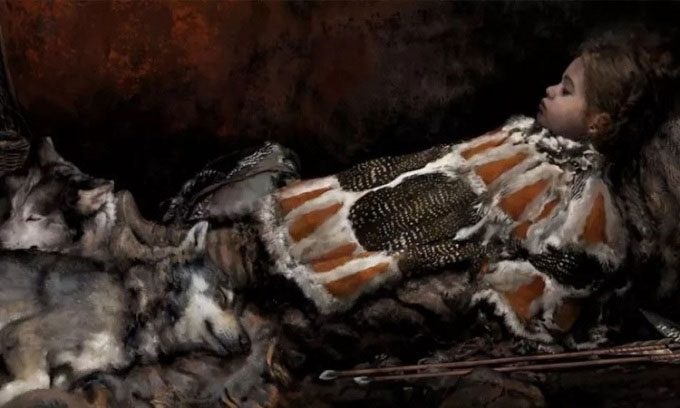Stone Age Grave Containing Child Remains, Bird Feathers, and Wolf Fur Reveals Primitive Burial Customs
First discovered in 1991 at Majoonsuo, an archaeological site near the town of Outokumpu in eastern Finland, the grave contained a child’s tooth. Based on the tooth analysis, archaeologists from the Finnish Heritage Agency in Helsinki determined that the child died between the ages of 3 and 10. They speculated that this was a burial site due to the presence of ochre, a type of iron-rich earth often associated with cemeteries and rock art. The excavation team from the Finnish Heritage Agency examined the site in 2018 and concluded that it was at risk of being destroyed, as reported by Live Science on November 7.

Reconstruction of the child’s appearance in the Stone Age grave. (Photo: Tom Björklund)
Based on the shape of two arrowheads made of quartz, archaeologists estimated that the grave dates back to the middle Stone Age, approximately 8,000 years ago. After analyzing soil samples, the research team discovered down feathers from a waterfowl species that may have been used as bedding for the child. They also found a bird feather, possibly from a hawk, which could have been used to fletch arrows or decorate clothing.
At the bottom of the grave, there were 24 patches of mammal fur. Although many of the hairs were damaged, researchers noted that some came from canids, likely wolves, placed at the child’s feet. Dog fur may also have originated from clothing or shoes made from wolf leather.
“Dogs buried with the dead have been found at Skateholm, in a famous grave dating back 7,000 years,” said Kristiina Mannermaa, an associate professor in the Department of Culture at the University of Helsinki. “The findings at Majoonsuo are remarkable, even though only animal fur remains.”
- Additionally, the archaeologists unearthed plant fibers, possibly from willow or nettle, used for weaving clothing or fishing nets. Given the high acidity of the soil in this area of Finland, the research team was surprised that some organic remains could survive for thousands of years.
- NASA Robot Captures “Living Ocean” on Mars
- 19-Year-Old Blacksmith Uses 4.5 Billion-Year-Old Meteorite to Forge Treasure Sword
- Wrong Opponent Chosen, Hyena Pays the Price for Donkey’s Naivety





















































